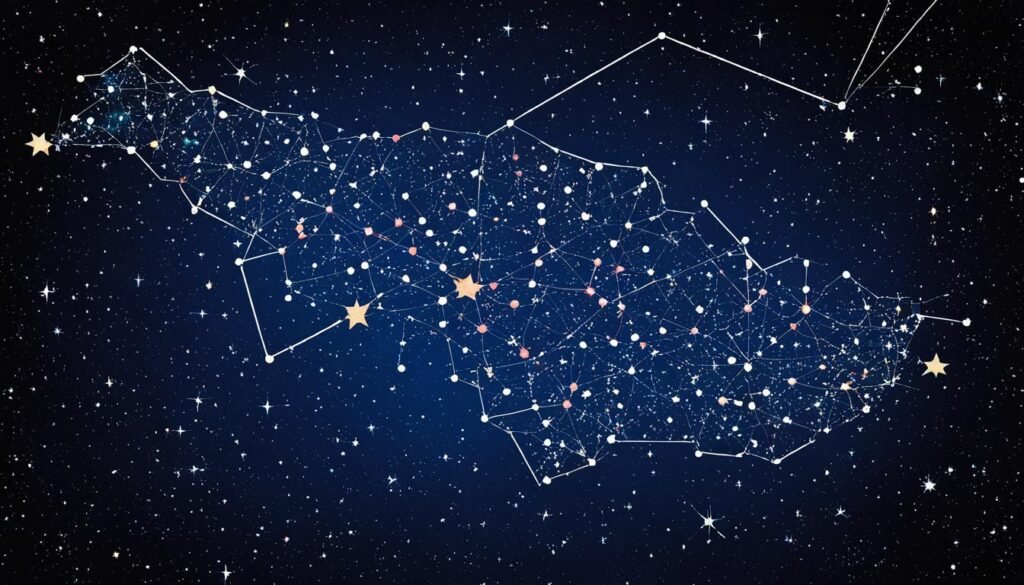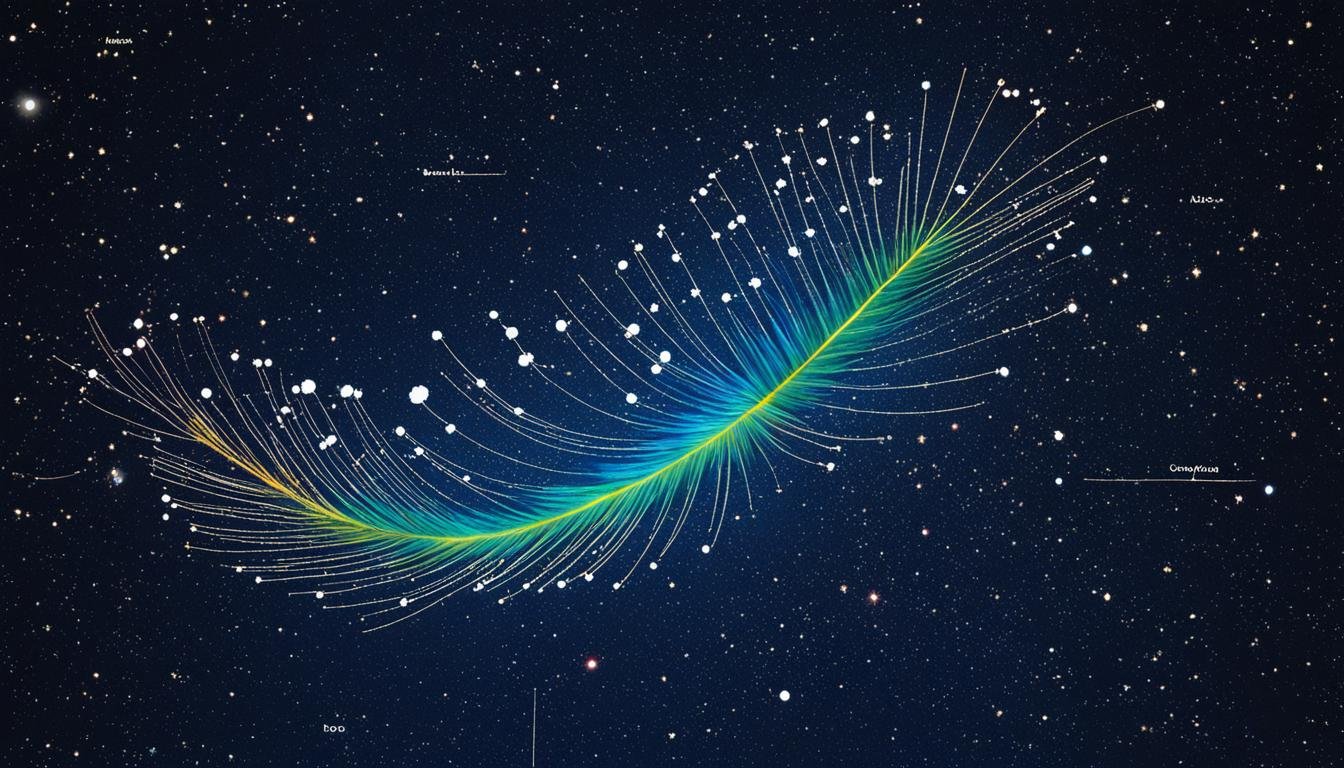| Genitive | |
| Abbreviation | |
| Pronunciation | |
| Main Stars | |
| Brightest Star | |
| Right Ascension | |
| Declination | |
| Sq. Deg. Area | |
| Crosses Meridian | |
| Visible Lat. Range |
Embark on a celestial expedition as you explore Pavo, a constellation that projects the grandeur of the night sky. Known as “the peacock” in Latin, Constellation Pavo showcases an array of twinkling stars, offering a magnificent spectacle for avid stargazers like you. Whether you’re charting a course through the southern cosmos or simply looking up to admire its beauty, this guide will illuminate the wonders of Pavo’s unique star pattern and its rich historical tapestry. From the Dutch navigators’ first observations in the 16th century to its current status among skywatchers, Pavo is celebrated not just for its place among constellations but also for its navigational prowess, particularly in Australia where it’s affectionately dubbed “the Saucepan. So stargazing Pavo becomes more than a pastime—it’s a journey through time and space.
With your eyes set on the luminaries of Pavo, you’ll encounter the radiant Peacock star and the solar analog Delta Pavonis, amidst galaxies that dance in cosmic harmony. Though lacking Messier objects, Pavo’s celestial real estate is far from barren, boasting five star systems with confirmed planets and being the radiant of an exclusive meteor shower, the Delta Pavonids. Prepare to delve into the 44th largest constellation in the sky and become an adept of the southern heavens.
Key Takeaways
- Understand the historical significance of Constellation Pavo and its discovery by Dutch navigators.
- Appreciate Pavo’s notable star pattern and learn to identify its most prominent stars, including Peacock and Delta Pavonis.
- Utilize tips for stargazing Pavo, including optimal viewing times and conditions.
- Explore Pavo’s deep-sky objects, such as the interacting galaxies NGC 6872 and IC 4970.
- Discover the mythology and cultural symbolism that Pavo holds across different civilizations.
- Acknowledge Pavo’s place in the Johann Bayer family of constellations.
- Prepare for a mesmerizing stargazing experience in the Southern Hemisphere, guided by Pavo’s celestial guideposts.
Unfolding the Mysteries of Constellation Pavo
When you cast your gaze to the heavens, you might discover the Pavo star cluster, a celestial tapestry woven by the hands of history and mythology. It’s a testament to human curiosity that this constellation holds not only stars but stories, patterns, and the legacy of an ancient sky observation culture. It is here, among these stellar clusters that the rich influence of Dutch astronomer Petrus Plancius persists, offering us a cosmic journey colored by Greek mythology and cultural symbolism.
Origin and Discovery: The Dutch Influence
The genesis of Pavo’s discovery is anchored in the pioneering spirit of Dutch astronomer Petrus Plancius. In collaboration with navigators, such as Frederick de Houtman and Pieter Dirkszoon Keyser, Plancius mapped the southern skies, gifting us with the Pavo celestial object analysis we understand today. His work exemplifies the transformative impact that diligent sky observation carries for future generations of astronomers and stargazers alike.
Marking the Heavens: Pavo’s Place Among the Stars
Positioned between latitudes +30° and -90°, Pavo rubs shoulders with constellations Apus, Ara, Indus, Octans, and Telescopium. Each star cluster and pattern nestled within it speaks to its pivotal place in our expansive night sky, serving as an astral anchor among a sea of celestial bodies. It is a constellation that commands attention, urging observers to marvel at the vastness and diversity of our universe.
Peacock in the Sky: Symbolism and Cultural Significance
Imbued with the splendor of Greek mythology, Pavo radiates with cultural symbolism reminiscent of the tales of Hera and her cherished hundred-eyed peacock, whose eyes adorn the constellation’s namesake bird. The intertwined stories reflecting the peacock’s majestic plumage and Argus’s many-eyed vigil enrich Pavo’s presence, marrying historical lore with the wonders of stellar interpretation.
| Cultural Element | Association with Pavo | Astronomical Significance |
|---|---|---|
| Greek Mythology | Peacock symbol of Hera | Inspiration for constellation’s name |
| Argus’s Eyes | Symbolic Eyes on Peacock’s Tail | Star cluster’s dazzling appearance |
| Dutch Exploration | Petrus Plancius’s Contribution | Historical discovery and mapping |
Astronomical Marvels of Pavo: Key Stars and Celestial Objects
When you gaze upon the Pavo constellation map, you’re met with an array of stars that shine as the jewels of the southern sky. Among them, two stars shine exceptionally bright: Alpha Pavonis, more commonly known as Peacock, and Delta Pavonis. The former, Alpha Pavonis, is a stunning example of a blue-white subgiant star, boasting an impressive apparent magnitude of 1.94 and earning its place as the brightest star in Pavo’s star formation.

Peacock’s spectral classification brings it to the subgiant stellar class B2 IV and reveals it as part of a binary system, accompanied by an enigmatic spectroscopic partner whose details remain elusive. Beyond Alpha Pavonis, other luminaries like Beta Pavonis and Gamma Pavonis contribute to the constellation’s luster, with the latter located just 30.21 light years from Earth and surpassing the Sun in both mass and luminosity.
Delta Pavonis also captures the attention of astronomers for its closeness to our solar system and its G8 IV spectral classification. Recognized as a solar analog, this subgiant star becomes an intriguing subject in the hunt for extraterrestrial life, its similarities to our Sun positing it as an ideal candidate for future exploration.
| Star | Spectral Classification | Star Type | Notable Features |
|---|---|---|---|
| Alpha Pavonis (Peacock) | B2 IV | Blue-white Subgiant | Brightest in Pavo, binary system |
| Delta Pavonis | G8 IV | Subgiant Solar Analog | Close proximity to Sun, potentially habitable |
| Gama Pavonis | F8 IV | Yellow-white Subgiant | Nearby, larger and more luminous than Sun |
By immersing yourself in the wonders of the Pavo star formation, you are not just exploring stars and space; you’re uncovering part of the grand tapestry that makes up our universe. The Pavo constellation, with its notable stars and celestial objects, offers a stunning celestial spectacle that captivates both amateur stargazers and professional astronomers alike.
Constellation Pavo: A Stargazer’s Primer
As you set your sights on the stars, the constellation Pavo emerges as a celestial tapestry rich in history and wonder, offering the best stargazing experience for aficionados and novices alike. Located in the domain of the Southern Hemisphere, Pavo’s graceful outline can guide you through the night’s canvas.

Observing the “Saucepan”: A Guide for Southern Observers
In the land down under, Pavo is affectionately known as “the Saucepan,” a point of reference that has guided many Southern Hemisphere observations. With its position firmly in the southern sky, Pavo becomes your celestial compass, leading you to the splendors of the cosmos.
Stargazing Tips for Spotting Pavo’s Brightest Stars
To truly appreciate the grandeur of Pavo, you will need to embrace optimal stargazing conditions. Venturing out on a clear, moonless night away from the glow of urban landscapes, your eyes will adjust to the darkness, unveiling Pavo’s most luminous stars.
- Seek out locations known for their dark skies.
- Let your eyes adapt to darkness for about 20-30 minutes for enhanced sensitivity.
- Utilize a star map or a stargazing app to help identify Pavo among its neighboring constellations.
- Consider using binoculars to capture a clearer view of Pavo’s stellar arrangement.
The Optimal Times and Locations for Viewing Pavo
Timing is paramount when it comes to stargazing, and Pavo graciously presents itself at its prime during August at approximately 9 PM. To behold its magnificence, chart a course to rural landscapes where the veil of light pollution is lifted, revealing Pavo in its full astronomical glory.
- Late winter to early spring is ideal for Southern Hemisphere observations.
- Set your stargazing session for when Pavo is highest in the sky to minimize atmospheric distortion.
- Coordinate your adventure with the lunar cycle, targeting the new moon for the darkest skies.
Embark on a celestial voyage to the Southern Hemisphere where Pavo awaits, its stars twinkling with anticipation. With these constellation viewing tips at your disposal, you’re primed to capture the essence of the night sky. Go forth, look up, and let the stars guide you to the wonders of Pavo.
Deep Sky Delights: Pavo’s Cluster and Galaxy Showcases
As you venture into the realm of celestial observation, the Pavo constellation emerges as a spectacular gallery of cosmic artistry. Housing the eminent NGC 6752 globular cluster, Pavo invites you to gaze upon an assembly of ancient stars, densely packed in a spherical formation. This lustrous cluster is not only a beacon among Pavo deep sky objects, inviting awe with its stellar brilliance, but also the backdrop for the elusive Bedin 1, a newly discovered galaxy that teases the curiosity of astronomers and stargazers alike.
The Pavo constellation holds yet another marvel, the Condor Galaxy (NGC 6872), partnered in a gravitational dance with IC 4970. This pair of interacting galaxies offers a detailed view of the intricate processes that mold the universe. Engage in a Pavo galaxy view session to witness a spectacle rarely glimpsed — the grand forces of celestial mechanics at play, poignant reminders of the dynamic cosmos we are a part of.
Further complementing Pavo’s array of wonders is NGC 6744, which might be considered a distant cousin of our own Milky Way. This spiral galaxy serves as an exemplar for paralleling the familiar structure and allure of our celestial haven. Collectively, these deep sky phenomena reinforce the essence of the Peacock constellation, a cosmic stage that narrates a tale of gravity, light, and the profound depth of our observable universe. Your stargazing expeditions will be richly rewarded with these and other sights, nestled in the fabric of the Pavo constellation.
FAQ
What is the historical significance of the constellation Pavo?
The historical significance of the constellation Pavo traces back to Dutch navigators and the astronomer Petrus Plancius in the 16th century. It was first depicted by Plancius from the observations of navigators who traveled to the southern seas and was then included in Johann Bayer’s “Uranometria” star atlas, cementing its place in celestial cartography.
How did Pavo get its name and what does it symbolize?
Pavo gets its name from the Latin word for “peacock” and symbolizes the bird in Greek mythology that is associated with the goddess Hera. The constellation’s stars represent the peacock’s tail feathers, which in the myth were adorned with the hundred eyes of the giant Argus, honored by Hera after its death. This demonstrates the rich cultural symbolism attached to Pavo.
What are the key stars in the constellation Pavo?
Key stars in the Pavo constellation include Alpha Pavonis (Peacock), the brightest star within the constellation; Delta Pavonis, a solar analog that’s a prime target in the search for extraterrestrial intelligence; and Gamma Pavonis, a star with greater mass and luminosity than our Sun. These stars are among the luminaries that make Pavo a notable constellation.
Can you give tips for observing the constellation Pavo?
To observe the constellation Pavo, it’s best to find a dark location away from urban light pollution. The constellation is most visible from the Southern Hemisphere during late winter to early spring, around 9 PM in August. Look for Pavo nestled between the neighboring constellations of Indus and Telescopium. Use a constellation map for guidance, and if in Australia, remember that it’s known as “the Saucepan” to help orientate yourself.
What makes the constellation Pavo special to stargazers?
Pavo is a southern constellation that offers various deep sky objects for stargazers, such as the globular cluster NGC 6752, the barred spiral galaxy NGC 6744, and the interactive galaxies NGC 6872 and IC 4970. Furthermore, Pavo’s bright stars like Peacock and Delta Pavonis provide a mesmerizing view. Its distinctive star pattern and the absence of Messier objects give it a unique charm among constellations.
What are the best conditions for stargazing in Pavo?
The best conditions for stargazing in the Pavo constellation are clear, dark skies with minimal light pollution, typically found in rural or remote areas. Optimal stargazing occurs when Pavo is high in the sky, from late winter to early spring in the Southern Hemisphere. It’s also best observed during its peak visibility around 9 PM in August when the constellation is best positioned.
Are there any notable deep sky objects in Pavo?
Yes, Pavo features several notable deep sky objects. These include NGC 6752, a bright globular cluster with the newly discovered background galaxy Bedin 1; NGC 6872, the Condor Galaxy, and its companion IC 4970; and NGC 6744, which resembles our Milky Way. These objects contribute to Pavo’s appeal to astronomers and deep sky observers alike.
What is the visibility range of the constellation Pavo?
The visibility range for the constellation Pavo extends between latitudes +30° and -90°, making it observable from the Southern Hemisphere and partially from the Northern Hemisphere. It is best viewed in its entirety from locations further to the south, where it is circumpolar and visible throughout the year.
Does the constellation Pavo have any planetary systems?
Yes, the constellation Pavo is known to have at least five stars confirmed to have planets orbiting around them. This adds an extra layer of intrigue for astronomers and astrobiologists, especially considering the solar analog Delta Pavonis, which could be a promising site for hosting an extraterrestrial civilization.
What meteor showers are associated with Pavo?
The constellation Pavo is associated with a singular meteor shower called the Delta Pavonids. It’s an annual shower that contributes to the constellation’s observational appeal. Stargazers can look forward to this celestial display, although the meteor shower is not as prolific as some of the more well-known showers.







